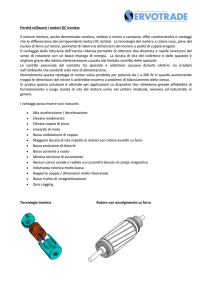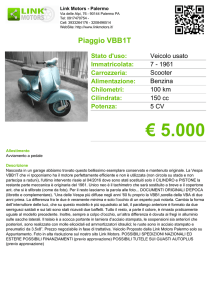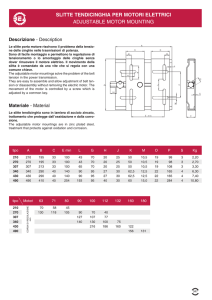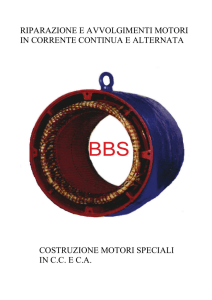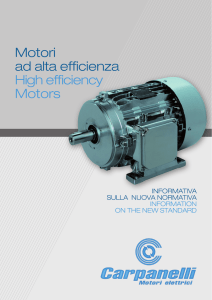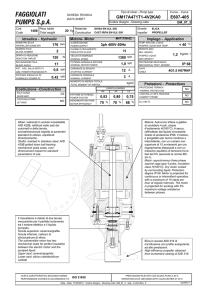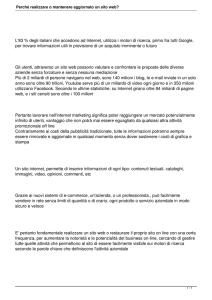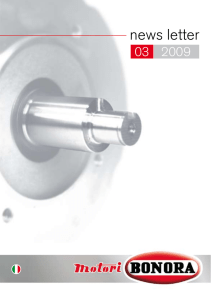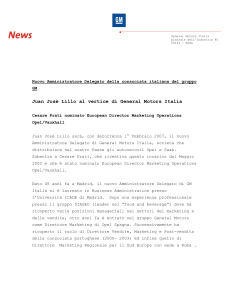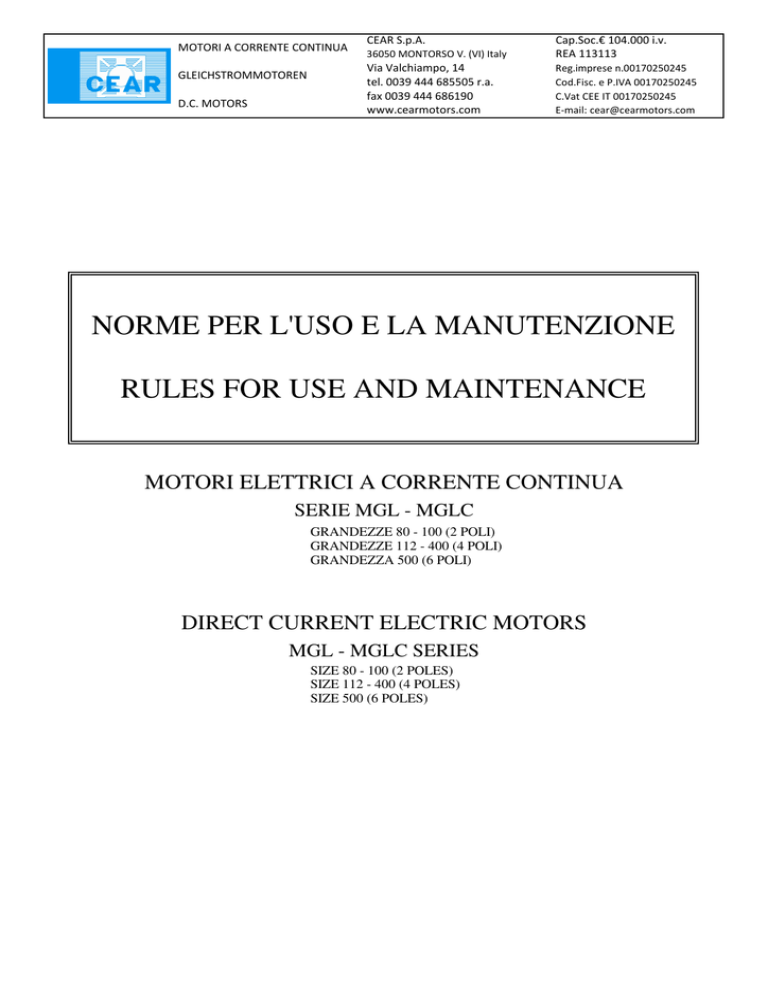
MOTORI A CORRENTE CONTINUA
GLEICHSTROMMOTOREN
D.C. MOTORS
36050 MONTORSO V. (VI) Italy
CEAR S.p.A.
Cap.Soc.€ 104.000 i.v.
REA 113113
Via Valchiampo, 14
tel. 0039 444 685505 r.a.
fax 0039 444 686190
www.cearmotors.com
Reg.imprese n.00170250245
Cod.Fisc. e P.IVA 00170250245
C.Vat CEE IT 00170250245
E-mail: [email protected]
NORME PER L'USO E LA MANUTENZIONE
RULES FOR USE AND MAINTENANCE
MOTORI ELETTRICI A CORRENTE CONTINUA
SERIE MGL - MGLC
GRANDEZZE 80 - 100 (2 POLI)
GRANDEZZE 112 - 400 (4 POLI)
GRANDEZZA 500 (6 POLI)
DIRECT CURRENT ELECTRIC MOTORS
MGL - MGLC SERIES
SIZE 80 - 100 (2 POLES)
SIZE 112 - 400 (4 POLES)
SIZE 500 (6 POLES)
Page 2 of 25
MOTORI ELETTRICI A CORRENTE CONTINUA
DIRECT CURRENT ELECTRIC MOTORS
INDICE
INDEX
1
1.1
1.2
1.3
1.4
1.5
1.6
1.7
Generalità
Introduzione
Norme di riferimento
Rappresentazione grafica
Lista componenti
Dati di targa del motore
Spedizione e movimentazione
Giacenza in magazzino
1
1.1
1.2
1.3
1.4
1.5
1.6
1.7
General
Introduction
Reference standards
Drawings
Parts lists
Motor plate data
Delivery and handling
Store stock
2
2.1
2.2
2.3
Montaggio
Installazione
Piazzamento
Accoppiamento
2
2.1
2.2
2.3
Mounting
Installation
Positioning
Coupling
3
3.1
3.2
3.3
3.4
3.5
Messa in servizio
Collegamenti elettrici
Ispezioni prima dell'avviamento
Avviamento
Ispezioni dopo l'avviamento
Corrente di alimentazione
3
3.1
3.2
3.3
3.4
3.5
Setting in function
Electrical connections
Checks before starting up
Starting
Inspection after starting
Supply current
4
4.1
4.2
4.3
4.4
4.5
4.6
Manutenzione
Manutenzione programmata
Collettore
Spazzole
Procedura adattamento spazzole
Cuscinetti
Dinamo tachimetrica o Encoder
4
4.1
4.2
4.3
4.4
4.5
4.6
Maintenance
Scheduled maintenance
Commutator
Brushes
Brushes adjustment procedure
Bearings
Tachometer or Encoder
5
5.1
Smontaggio
Operazioni da eseguire
5
5.1
Dismantling
What to do
6
6.1
6.2
6.3
Anomalie di funzionamento
Anomalie meccaniche
Anomalie elettriche
Anomalie alle spazzole
6
6.1
6.2
6.3
Operation anomalies
Mechanical faults
Electrical faults
Brushes faults
Appendice
Indici di commutazione
Appendix
Index of commutation
Richiesta di assistenza e parti di ricambio
Inquiry of assistance and spare parts
INDICE TABELLE
Carichi radiali massimi con cuscinetti a sfere
Carichi radiali massimi con cuscinetti a rulli
Caratteristiche elettroventilatori
Dimensioni spazzole
Caratteristiche spazzole
Manutenzione cuscinetti
TABLES INDEX
Maximum radial load with balls bearings
Maximum radial load with rollers bearings
Electric fan characteristic
Brush dimension
Features brushes
Bearings maintenance
Page 3 of 25
MOTORI ELETTRICI A CORRENTE CONTINUA
DIRECT CURRENT ELECTRIC MOTORS
1
GENERALITA'
1
GENERAL
1.1 Introduzione
Scopo del presente manuale è quello di fornire le
informazioni necessarie per l'utilizzo e la manutenzione dei motori CEAR a corrente continua, al fine
di ottenere un'affidabilità e una durata di vita soddisfacenti.
Per tutti i casi particolari, informazioni o accessori
non contemplati nel manuale, interpellare la CEAR.
1.1 Introduction
The purpose of this handbook is to provide the
information necessary for the operation and
maintenance of DC electric motors CEAR, in order
to obtain reliability and life satisfaction.
1.2 Norme di riferimento
I motori della serie MGL - MGLC sono costruiti
secondo la normativa italiana CEI EN 60034-1
conforme alla IEC 60034-1 e quindi armonizzati
alle norme dei principali Paesi Europei.
1.2 Standards References
MGL and MGLC series motors are build according
to standard CEI EN 60034-1 in complies with IEC
60034-1 and then harmonized with standards of
most European Countries.
For all particular cases, information or accessories
not covered in this manual, please ask to CEAR
REFERENCE STANDARDS
CEI EN 60034-1
Rating and performances
CEI EN 60034-2
Methods for determining losses and efficienty
CEI EN 60034-5
Classification of the degrees of protection
CEI EN 60034-6
Methods of cooling (IC code)
CEI EN 60034-7
Type of construction and mounting arrangements (IM code)
CEI EN 60034-8
Terminal markings and direction of rotation
CEI EN 60034-9
Noise limits
CEI EN 60034-14
Mechanical vibrations of rotating machines
2006/95/CE
Low voltage directive
2006/42/CE
Machine directive
Page 4 of 25
MOTORI ELETTRICI A CORRENTE CONTINUA
DIRECT CURRENT ELECTRIC MOTORS
1.3
Rappresentazione grafica
1.3
Drawings
Motore serie MGL
Motor MGL series
Page 5 of 25
MOTORI ELETTRICI A CORRENTE CONTINUA
DIRECT CURRENT ELECTRIC MOTORS
1.4
Lista componenti
1.4
Parts lists
1
2
3
4
5
6
7
8
9
10
11
12
13
15
16
17
18
19
20
21
22
23
24
25
26
27
28
29
30
31
32
Sporgenza d'albero
Cuscinetto lato accoppiamento
Avvolgimento di rotore
Scudo lato accoppiamento
Viti fissaggio scudi - statore
Bobina poli principali
Nucleo poli principali
Statore lamellare
Golfari di sollevamente
Scudo lato opposto
Cassetto portaspazzole e spazzole
Spazzole
Molle spingi spazzole
Anello portaspazzole
Cuscinetto lato opposto
Collettore
Portello ispezione lato opposto
Scatola morsettiera
Portello lato accoppiamento
Coperchietto interno lato accoppiamento
Coperchietto interno lato opposto
Lanterna attacco D.T.
Giunto elastico di adattamento D.T.
Filtro ventilatore
Staffe di sostegno filtro
Voluta ventilatore
Motore ventilatore
Relè anemostatico
Bobina poli ausiliari
Nucleo poli ausiliari
Pacco rotore
1
2
3
4
5
6
7
8
9
10
11
12
13
15
16
17
18
19
20
21
22
23
24
25
26
27
28
29
30
31
32
Shaft end
Bearing coupling side
Engine winding up
Coupling shield side
Fixing screws shield-box
Coil mains poles
Nucleous mains poles
Blades package stator
Lifting ring
Opposide shield side
Drawer brushes-holder
Brushes
Spring
Brushes-holder ring
Bearing opposide side
Collector
Opposide side inspection door
Terminal board
Coupling side door
Coupling side interior small-cover
Opposide side interior small-cover
Lantern for Tachogenerator
Elastic Joint for tachogenerator
Ventilator filter
Support filter stirrups
Ventilator carter
Ventilator engine
Air flow control relay
Auxiliarys poles bobbin
Necleus auxiliarys poles
Rotor package
Page 6 of 25
MOTORI ELETTRICI A CORRENTE CONTINUA
DIRECT CURRENT ELECTRIC MOTORS
1.5 Dati di targa del motore
Ogni macchina a corrente continua prodotta dalla
CEAR è munita di una targhetta identificativa
comprensiva della marcatura CE.
Sulla targhetta sono riportati i dati nominali relativi
alle prestazioni della macchina.
1.5 Motor data plate
Each Dc motors produced by CEAR has a data
plate with CE marking.
On this data plate are indicated all nominal datas
regarding the performance of the motor.
Significato dei simboli:
Meaning of the symbols:
Type
N°
P
rpm
Ua
Ia
Uf
If
IM…
IP…
IC…
Duty
Tam
Cl.
Alt.
Exc.
J
m
Type
N°
P
rpm
Ua
Ia
Uf
If
IM…
IP…
IC…
Duty
Tam
Cl.
Alt.
Exc.
J
m
motor type (code CEAR)
serial number and year
nominal power of the motor in
nominal speed of the motor in
nominal voltage of the motor in
nominal current of the motor in
nominal field voltage in
nominal field current in
mounting
degree of protection
type of ventilation
type of service
maximun ambient temperature in
insulation class
maximun altitude of installation in
type of excitation
rotor inertia moment in
mass of the motor in
1.6
Delivery and handling
tipo di motore (secondo codice CEAR)
numero di matricola e anno
potenza nominale del motore in
velocità nominale del motore in
tensione nominale del motore in
corrente nominale del motore in
tensione nominale di eccitazione in
corrente nominale di eccitazione in
forma costruttiva
grado di protezione
tipo di ventilazione
tipo di servizio
temperatura ambiente massima in
classe di isolamento
altitudine massima di installazione in
tipo di eccitazione
momento d'inerzia rotore in
massa del motore in
Kw
rpm
V
A
V
A
°C
m
Kgm2
Kg
1.6 Spedizione e movimentazione
La spedizione delle macchine viene effettuata
normalmente senza imballaggio, salvo esplicita
richiesta. E' bene che siano esaminate appena
giunte a destinazione per assicurarsi che non abbiano subito alcun danneggiamento.
Il sollevamento e il trasporto delle macchine deve
essere effettuato agganciando il golfare o le orecchie laterali applicate alla carcassa. Qualora il cari-
Kw
rpm
V
A
V
A
°C
m
Kgm2
Kg
Delivery of machines is usually effected without
packaging, excepted clear opposite request. Good
enough that machines will be checked when
reached destination to be insured about eventual
damagements.
Lifting and tranport of machines must be made
linking connecting points placed on frame of
machine. When charge is unbalanced it is needed
Page 7 of 25
MOTORI ELETTRICI A CORRENTE CONTINUA
DIRECT CURRENT ELECTRIC MOTORS
co risultasse sbilanciato è opportuno usare un laccio
addizzionale per equilibrare il peso. Non utilizzare
per il sollevamento altre parti del motore anche se
munite di organi di sollevamento come ventilatori o
scambiatori.
Il peso di ogni motore è riportato sulla sua targhetta.
making use of an additional rope to re-balance
wheight. Do not use for lifting other parts of the
motor, even when equipped with lifting devices
such as fans or heat exchangers.
The weight of each motor is shown on its motor
plate.
non utilizzare
do not use
CEAR
Sollevamento in corrispondenza del baricentro del motore
Uplift at the center of gravity of the motor
1.7 Giacenza in magazzino
Nel caso che le macchine non vengano utilizzate
subito, dovranno essere riposte in luoghi coperti,
puliti, asciutti e al riparo da brusche variazioni di
temperatura. Durante la giacenza in detti reparti
gli avvolgimenti delle macchine dovranno essere
protetti dall'umidità e così pure le altre parti soggette a corrosione. Sull'estremità d'albero, se necessario, và ripristinato lo strato di vernice protettiva
con opportuni prodotti anticorrosione e antiossidanti.
Per evitare qualsiasi inconveniente ai cuscinetti,
qualora la macchina dovesse rimanere ferma per
diversi mesi, è bene far girare l'albero di alcuni giri
ogni due o tre mesi.
Altri punti da proteggere dalla corrosione sono i
contatti tra spazzola e collettore, onde evitare una
cattiva commutazione di funzionamento. Per evitare
ciò basterà tenere sollevata la spazzola mediante
la pressione laterale della molla situata nel relativo
portaspazzole. Se i motori sono rimasti per lungo
tempo a basse temperature, vanno lasciati per
alcuni giorni a temperatura ambiente per eliminare
l'eventuale condensa.
1.7
Store stock
When machines are not immediatly used, one
must place them in covered, clean and dirty
places, without abrupt changes in temperature.
During the store in such places, motors
unwindings will have to be protected from the
wear and same for all other parts subjected to
corrosion. To avoid any inconvenient to bearings,
when machine is standing out of work for various
months, it is usefull to have the shaft rotating also
only a few revolutions every two or three months.
Other points to be protected from corrosion are
contacts between brush and collector, to avoid
any bad functioning-commutation.
To avoid such a problem, it will be enough
holding the brush a few lifted through lateral
pressure of the spring placed in the relative
brushes-holder.
If the motors have been stored for a long time at
low temperature, keep them at room temperature
for a few days to eliminate any condensate.
Page 8 of 25
MOTORI ELETTRICI A CORRENTE CONTINUA
DIRECT CURRENT ELECTRIC MOTORS
2
MONTAGGIO
2
MOUNTING
2.1 Installazione
Le macchine devono essere installate in modo che
le portelle per le normali ispezioni di manutenzione
alle spazzole e al collettore siano di facile accessibilità.
Le bocchette di scarico aria non devono essere
ostruite ed evitare che l'aria calda in uscita entri
nuovamente in circolo nel motore.
Evitare la presenza di fonti di calore ed eventuali
strozzature nel prelievo dell'aria di raffreddamento.
Evitare lo sgocciolamento di liquidi sul filtro e vicino
la zona di aspirazione.
2.1 Installation
the motors should be installed so that the doors for
regular brushes maintenance inspections and for
commutator must be easy to access.
2.2 Piazzamento
Il piazzamento della macchina deve rispettare la
forma costruttiva riportata in specifica tecnica e in
targhetta. I piani di appoggio o la controflangia di
applicazione devono essere rigidi ed esenti da
deformazioni o vibrazioni.
Le macchine ad asse orizzontale su piedini vanno
fissate con 4 viti di diametro adeguato al foro dei
piedi. Il piano di appoggio deve essere uniforme e
in grado di sopportare le coppie prodotte dalla
macchina.
Le macchine fissate tramite flangia, devono essere
bloccate con un numero di viti adeguato ai fori della
flangia. La superficie della controflangia deve
essere adeguatamente lavorata per garantire planarità e perpendicolarità all'asse della macchina.
2.2 Placement
The placement of the motor must respect the
construction form indicated in the technical sheet
and on the data plate. The shelves or the
application counter must be rigid and free from
deformation of vibration.
2.3 Accoppiamento
L'accoppiamento va effettuato con la massima
cura per assicurare un buon funzionamento del
motore. Il calettamento degli organi di trasmissione
va fatto con attrezzature adeguate e da personale
esperto.
In caso di accoppiamento a giunto, rigido o elastico,
curare bene l'allineamento fra l'albero motore e
l'albero della macchina movimentata con tolleranza
massima di 0.05 mm. Un allineamento inpreciso
genera notevoli sollecitazioni ai cuscinetti ed un
funzionamento irregolare con vibrazioni e spinte
assiali. I rotori dei motori sono equilibrati con mezza
chiavetta, assicurarsi quindi che anche gli organi
di trasmissione montati siano equilibrati nello stesso
modo.
Nel caso di accoppiamento diretto a bagno d'olio,
assicurarsi che sulla sporgenza d'albero sia montato
l'apposito anello Angus fornito solo su richiesta.
Nel caso di accoppiamento con puleggia e cinghie,
verificare che gli alberi siano perfettamente
2.3 Coupling
The coupling must be made by carefully to ensure
a good running of the motor.
The fitting of the transmission must be dome with
appropriate equipment and expert personelle.
The air exhaust vents should not be obstruct in
order to avoid that the hot air out come
re-circulating again in the motor.
Avoid the presence of heat sources and any
bottlenecks in the withdrawal of cooling air.
Avoid spilling liquid on the filter and close the intake
area
The horizontal axis motors must be fixed with 4
screws with a suitable diameter of the hole feet.
The support surface must be uniform and able to
withstand the torques produced by motor.
The motor fixed by flange must be blocked with a
suitable number of screws like the flange holes.
The counter surface must be adeguately processed
to enusres flatness and perpendicular to the axis of
The motor.
In case of coupling by joint, rigid or elastic, treat
well the alignment between the motor shaft end and
the shaft of the machine handled with a tolerance
maximum of 0,05mm. A bad alignment generates
a lot of strain on the bearings and irregular operation
with vibrations and thrust loads. The rotors of the
motors are balanced with half key, so make sure
that the trasmission mounted are balanced in the
same way
In the case of direct coupling in an oil bath, make
sure that on the shaft end is mounted the special
Angus oil ring, supplied only on request.
In the case of coupling by belt and pulley, check
that the shaft ends are perfectly parallel and pulleys
Page 9 of 25
MOTORI ELETTRICI A CORRENTE CONTINUA
DIRECT CURRENT ELECTRIC MOTORS
paralleli e le pulegge allineate. Per questo tipo di
accoppiamento è buona cosa usare delle slitte
tendicinghia che devono essere fortemente ancorate alle fondazioni del basamento. La tensione delle
cinghie non deve essere eccessiva per non
sottoporre il cuscinetto a sforzi radiali esagerati.
Se l'accoppiamento è a puleggia, è sempre preferibile comunicarlo alla CEAR in fase d'ordine per
la verifica a nostra cura degli sforzi radiali e della
flessione d'albero. La verifica viene fatta compilando l'apposito modulo che sarà inviato di cui sotto
si riporta un esempio.
aligned. For this type of coupling is a good thing use
the slide rails to be strongly anchored to the
foundation of the basement. The strap tension
should not be excessive to not subject the bearing
to exaggerated radial forces.
If the couplement is by pulley, it is always
preferable inform CEAR at time of order, to check
the radial loads and shaft flex. The checking is
done by filling out a form sent to the customer
(below is an example)
X
Fr
=
Dp
=
LM
LF
La larghezza della puleggia non deve superare il
doppio dell'estremità d'albero, affinchè la risultante
del tiro cinghia sia sempre applicata entro la sporgenza d'albero (quota X).
Per verificare che il carico radiale sia inferiore a
quello massimo consentito per una durata dei
cuscinetti di 20.000 ore si utilizza la formula:
Tc = 19.5 × K ×
dove abbiamo:
P (Kw)
potenza del motore
D (mm)
diametro della puleggia
n (rpm)
velocità del motore
K
coefficiente dipendente dal tipo di
cinghia
K=1-1.5 cinghie dentate
K=2-2.5 cinghie trapezoidali
K=3-4
cinghie piane
The width of the pulley does not exceed the double
of the shaft end, so that the resultant of the belt
tension is always applied within the shaft end
(X dimension)
To verify that the radial load is less than the
maximum allowed for a period of bearings of
20.000 hours, using the formula :
P
× 10 6
n×D
(newton)
where we have :
P (Kw)
motor power
D (mm)
pulley diameter
n (rpm)
motor speed
K
coefficient depending on the type of
belt
K=1-1.5 toothed belts
K=2-2.5 trapezoidal belts
K=3-4
flat belts
Page 10 of 25
MOTORI ELETTRICI A CORRENTE CONTINUA
DIRECT CURRENT ELECTRIC MOTORS
Il valore ottenuto deve essere inferiore o uguale a
quelli riportati nelle seguenti tabelle.
The value obtained should be less than or equal to
those in the following tables.
Carichi radiali massimi consentiti con cuscinetti a sfere
Maximum allowable radial load with ball bearings
Speed n/1'
1000
1500
2000
2500
Motor
X
Tc
Tc
Tc
Tc
Type
(mm)
(N)
(N)
(N)
(N)
25
1420
1220
1100
1000
80
50
1320
1130
1010
920
30
1740
1550
1340
1220
100
60
1600
1430
1240
1130
40
2540
2160
1940
1760
112
80
2370
2030
1810
1640
55
2970
2540
2210
2020
132
110
2700
2320
2050
1890
55
3780
3240
2920
2680
160
110
3560
3020
2700
2480
55
4970
4260
3860
3510
180
110
4700
4050
3620
3290
70
6460
5570
5060
4470
200
140
5970
5170
4700
4160
85
7720
6590
5930
5160
250
170
7210
6150
5540
4820
Carichi radiali massimi consentiti con cuscinetti a rulli
Maximum allowable radial load with rollers bearings
Speed n/1'
1000
1500
2000
2500
Motor
X
Tc
Tc
Tc
Tc
Type
(mm)
(N)
(N)
(N)
(N)
55
6600
5800
5300
4900
132
110
4370
3850
3500
3250
55
9900
8900
8200
7600
160
110
6550
5900
5400
5000
55
11400
10150
9250
8650
180
110
7500
6700
6100
5700
70
14450
12830
11580
10850
200
140
9100
8080
7290
6830
85
20000
17600
16200
250
170
14150
12550
11400
3000
Tc
(N)
940
870
1130
1050
1620
1510
1870
1730
2480
2320
3290
3080
4220
3930
3000
Tc
(N)
4600
3050
7150
4700
3
MESSA IN SERVIZIO
3
3.1
Collegamenti elettrici
3.1 Electrical connections
Machines are equipped of a box containing
unwindings terminals. Seen from coupling side this
box is placed normally on right side of frame,
except special customer's needs.
Connections to the terminal box must be executed
according to the enclosed dyagram, thus having
polarities and rotation sense in according to
relative exigences.
Le macchine sono dotate di una scatola che contiene la morsettiera con i capi terminanti degli
avvolgimenti. Vista dal lato accoppiamento la
scatola è fissata normalmente sulla parte destra
della carcassa, salvo particolari richieste del cliente.
I collegamenti alla morsettiera devono essere eseguiti secondo lo schema allegato alla macchina, in
modo che la polarità e il senso di rotazione risultino
Page 11 of 25
SETTING IN FUNCTION
MOTORI ELETTRICI A CORRENTE CONTINUA
DIRECT CURRENT ELECTRIC MOTORS
Brushes-holder arch is placed on neutral plane, to
allow machine correcly running in the two rotation
senses. Only in the case of little motors without
auxiliary poles, the brushes-holding arch could be
found moved in regards to neutral plane and for
rotation sense requested.
conformi alle relative esigenze.
L'arco portaspazzole viene posto sul piano neutro,
per consentire alla macchina di girare correttamente nei due sensi di rotazione. Solo nel caso di piccoli
motori senza poli ausiliari, l'arco portaspazzole
potrà trovarsi spostato rispetto al piano neutro e per
il senso di rotazione richiesto.
La macchina deve sempre essere collegata
all'impianto di terra relativo al luogo di installazione.
La posizione ottimale rilevata in collaudo viene
indicata con un segno sul collare e sullo scudo.
Fino all'altezza d'asse 200 il morsetto di terra si
trova nella scatola morsettiera; per altezze d'asse
superiori un altro morsetto è applicato alla carcassa
del motore, entrambi contrassegnati con l'apposito
simbolo.
The machine must always be connected to the
earth on the place of installation.
The optimal position is found during the testing and
it is indicated with a sign on the collar and shield
Up to size 200 the ground terminal is placed inside
the terminal box; for higher size another terminal is
applied to the carcass of the motor, both marked
with the appropriated symbol.
A
G
Schema elettrico del motore
allegato all'interno della
scatola morsettiera.
+
+
-
B
J
Connections diagram
attached inside the motor
terminal box.
K
H
H
A
P
J
P
P
J
K
+
+
CLOCKWISE ROTATION
H
A
P
K
+
+
COUNTERCLOCKWISE ROT.
WHEN LOOKING DRIVE END
Esempio schema di collegamento / Example of electric connections
Marcatura dei terminali
A-B
avvolgimento d'indotto
G-H
avvolgimento poli ausiliari
J-K
avvolgimento eccitazione separata
P-P
termoprotettori klixon o PTC
Terminals marking
A-B
armature winding
G-H
winding of auxiliary poles
J-K
separate excitation winding
P-P
thrmo-protectors klixon or PTC
Nel caso di macchine con compensatori, i terminali
G-H si riferiscono ai poli ausiliari + compensatori.
In the case of machines with compensating
winding, the terminals G-H refer to the auxiliary
poles + compensating winding.
Other symbols
P1-P1
thermal motor pre alarm protection
type klixon or PTC
R1-R2
resistance thermometer PT100
A-A1 H-H1 terminals for the brush monitoring
S-S
space heater
Altri simboli
P1-P1
termoprotettori bimetallici klixon o
PTC di allarme
R1-R2
termometri a resistenza PT100
A-A1 H-H1 terminali controllo usura spazzole
S-S
scaldiglie anticondensa
Page 12 of 25
MOTORI ELETTRICI A CORRENTE CONTINUA
DIRECT CURRENT ELECTRIC MOTORS
3.2 Ispezioni prima dell'avviamento
Prima di avviare la macchina per la prima volta, o
dopo averla smontata, si faccia uno scrupoloso
esame di tutte le parti per assicurarsi che tutto sia
perfettamente a punto.
E' buona cosa controllare con un megaohmetro la
resistenza d'isolamento verso massa, la quale non
deve risultare inferiore a 0.5 megaohm. In caso
contrario l'inconveniente potrà essere eliminato
soffiando nella macchina aria calda, oppure
smontandola e mettendo le parti elettriche in forno
a 110°C per un paio d'ore.
Verificare che i motori asincroni dei ventilatori
(o scambiatori di calore) siano alimentati con
tensione e frequenza corrette, che girino nel verso
esatto e che i filtri siano puliti. Nel caso di ventilazione tamite condotte assicurarsi che portata e
pressione siano corrette.
Verificare che l'eventuale relè anemostatico
commuti correttamente con la presenza o meno
della ventilazione.
Controllare che la tensione di armatura e di
eccitazione corrispondano a quelle indicate in targa.
Controllare che le spazzole scorrano liberamente
dentro i propri cassetti, che le trecciole siano ben
fissate e che non vi siano stati danni durante il
trasporto; in questo caso sostituire le spazzole con
altre della stessa qualità e dimensione.
Verificare che tutti gli altri accessori e dispositivi di
protezione siano correttamente collegati e
funzionanti.
DC motor
MGL
80
100-112
132
160
180
200
250
280
315
400
500
3.2 Checks before starting up
Before starting the machine for the first time, or
after having dismantled it, one must carefully check
all its particulars in order to be sure that all is
perfectly all right.
Good thing is to check with a megaohmeter the
insulation resistance towards mass, which must be
not lower than 0.5 megaohm. In the contrary
inconvenient could also be solved blowing inside
machine warm air, or disassembling and putting
electrical parts into oven at 110°C for two hours
about.
Check that the asyncronous motors of the fans (or
heat exchanger) are fed with right tension and
frequency, that turn in the correct direction and that
filter are clean. In the case of ventilation ducts,
ensures that air flow and pressure is correct.
Check that the eventual anemometric switch is
properly with the presence or absence of
ventilation.
Check that the armature voltage and excitation
correspond to data plate.
Check that brushes slide freely in their drawer,
that the plaits are well fixed and that there were
no damages during the transport; in this case
replace the brushes with others of same quality
and dimensions.
Check that all other accessories and protection
devices are properly connected and working
Caratteristiche elettroventilatori / Electric fan characteristic
Power
Voltage
Current
Frequency
Air Flow
AC motor
(Kw)
(V)
(A)
(Hz)
(mc/1')
56M/2
0.12
230/400
0.9/0.52
50
4
63M/2
0.25
230/400
1.2/0.7
50
6
71M/2
0.55
230/400
2.8/1.61
50
10
80M/2
1.1
230/400
4.8/2.77
50
18
80M/2
1.5
230/400
6.1/3.53
50
23
28
90L/2
2.2
230/400
8.7/5
50
50
112M/4
4
230/400
15.6/9
50
62
112M/4
4
230/400
15.6/9
50
120
132S/4
5.5
230/400
20.8/12
50
150
132M/4
9.2
230/400
33.6/19.4
50
170
3.3 Avviamento
Per prima cosa verificare che il rotore possa girare
liberamente.
Si raccomanda, alla prima messa in marcia, di far
funzionare il motore a vuoto o a basso carico per
qualche ora, onde constatare che la temperatura
dei cuscinetti sia normale, che non vi siano
Pressure
(mmH2O)
45
70
80
100
115
130
120
125
130
130
150
3.3 Starting
First check that the rotor can rotate freely.
At the first starting, ti is necessary to have motor
running idle or at a low charge for some hours,
in order to check that bearings temperature is
normal, that there are not overheatings and that
Page 13 of 25
MOTORI ELETTRICI A CORRENTE CONTINUA
DIRECT CURRENT ELECTRIC MOTORS
sovrariscaldamenti elettrici localizzati e che le
spazzole si adattino al collettore.
brushes be proper to collector.
3.3 Ispezioni dopo l'avviamento
Una volta caricata la macchina si verifichi subito
che la commutazione sia regolare e che si crei
una patina uniforme sul collettore.
Verificare che la temperatura dei cuscinetti non
superi i 90°C.
Nel caso dovessero insorgere dei rumori o vibrazioni, se ne cerchi immediatamente la causa. Generalmente ciò è dovuto ad un impreciso allineamento,
eccessive spinte assiali e radiali, eccessivo grasso
nei cuscinetti.
Controllare che la corrente di eccitazione sia quella
indicata in targa tenendo presente che la resistenza aumenta di circa il 35% da motore freddo a
caldo con conseguente aumento dei giri; in targa
sono riportati i valori a caldo.
Verificare che la corrente di armatura sia inferiore
o uguale a quella di targa.
3.3 Inspection after starting
When machine is charged, verify that commutation
is regular and to form a uniform coating on the
collector.
Check that the temperature of the bearings does
not exceed 90°C.
When vibrations or other would be present, check
immediatly the reason. Generally this is due to an
incorrect alignement, excessive axial or radial
thrust, excessive grease in the bearings.
Check to see that the field current is the one shown
on the plate, whereas the resistance increases by
about 35% from cold to hot motor with resulting in
increased speed; the nameplate values are hot.
Check that the armature current of the motor is
below or equal to the one shown on the motor plate.
3.5 Corrente di alimentazione
I motori CEAR sono progettati per essere alimentati da convertitori trifasi interamente controllati.
Le prestazioni delle macchine sono quindi riportate
a catologo considerando un Fattore di Forma FF
diverso da 1, con i seguenti valori per le varie
altezze d'asse:
FF=1.1
per MGL80 - MGL132
FF=1.05
per MGL160 - MGL250
FF=1.03
per MGL280 - MGL400
FF=1.01
per MGL500
3.5 Feeding current
CEAR dc motors are designed to be powered by
three-phases converters wholly controlled.
The performance of the motors are reported
on the catalogue considering a Form Factor FF
different than 1, with the followed values for the
different frame sizes of motors :
FF=1.1
for MGL80 - MGL132
FF=1.05
for MGL160 - MGL250
FF=1.03
for MGL280 - MGL400
FF=1.01
for MGL500
Un fattore di forma più elevato può provocare
surriscaldamenti della macchina e un peggioramento della commutazione con relativi problemi.
Per FF elevati occorre quindi declassare le prestazioni della macchina o ridurre FF con un'induttanza
in serie al circuito d'armatura.
Il valore di induttanza da aggiungere in serie si può
calcolare come:
An higher Form Factor can provide overheating of
motor and switching can worst, causing problems.
For higher FF it is necessary downgrade the motor
performance or reduce FF with an inductance in
series added to the armature circuit.
The value of inductance to be added in series can
be calculated as :
LTOT = Lest + Lmot =
dove sono indicati:
Ltot induttanza totale (mH)
Lest induttanza da aggiungere (mH)
Lmot induttanza del motore (mH)
FF
fattore di forma desiderato
Icc
corrente assorbita dal motore (A)
Vco
( FF ) 2 + 1 I cc
K
×
where we denote by:
Ltot total inductance (mH)
Lest inductance to be added (mH)
Lmot motor inductance (mH)
FF
form factor
Icc
motor current (A)
Page 14 of 25
MOTORI ELETTRICI A CORRENTE CONTINUA
DIRECT CURRENT ELECTRIC MOTORS
Vco
K
4
tensione continua massima erogabile
1.35xVac per ponte trifase
0.898xVac per ponte monofase
fattore dipendente dal tipo di ponte
0.13 trifase interamenta controllato
0.37 trifase semicontrollato
1.46 monofase interamente contollato
1 monofase semicontrollato
Vco
MANUTENZIONE
4
K
maximum output continuous voltage
1.35xVac for three-phase bridge
0.898xVac for single-phase bridge
factor depending on the type of bridge
0.13 totally-controlled three-phase bridge
0.37 half-controlled three-phase bridge
1.46 totally-controlled single-phase bridge
1 half-controlled single-phase bridge
MAINTENANCE
4.1 Manutenzione programmata
Seguendo scrupolasamene un programma di
controllo si aumenta la durata della macchina e si
ottiene il miglior uso di tutto l'impianto.
Nel seguente specchietto si dà un'idea delle operazioni da eseguire periodicamente.
4.1 Scheduled maintenance
Following carefully a control programme one is
prolonging machine life obtaining the best use of
the whole line.
Following table gives use a idea about the
operations to be executed periodically.
OGNI MESE: tenere costantemente pulito il filtro
dell'aria e se necessario sostituirlo. Controllare il
funzionamento dei cuscinetti osservando che non
siano rumorosi e che non si verifichino aumenti
anomali di temperatura. Controllare lo stato di
consumo delle spazzole e sostituirle se si presume
che le trecciole annegate su di esse possano sfregare il collettore prima della prossima fermata.
Controllare la superficie del collettore, per scoprire
eventuali rugosità.
EACH MONTH: to constantly clean the air filter
and if necessary replace same. Check functionning
OGNI 3 MESI: controllare l'isolamento del motore
con un "megger". Accertarsi che la ventilazione sia
efficace e che non sia ostacolata da polveri o altri
materiali. Controllare che tutte le viti siano serrate
a fondo. Osservare che non siano insorte delle
vibrazioni o anomalie rispetto ai controlli precedenti.
EACH 3 MONTH: check the insulation of the
motor with a "megger". Be ascertained that
ventilation in correct without obstacles from
powders or other. Check that all screws are deeply
scew in. Observe that some vibrations or anomalies
in respect to previous controls be not present.
OGNI 6 MESI: esaminare le condizioni del grasso
dei cuscinetti e se necessario rinnovarlo. Misurare
l'isolamento della macchina e togliere con getti di
aria secca i depositi di polvere sugli avvolgimenti e
sul collettore. Osservare che non vi siano segni di
sovrariscaldamento localizzato. Controllare che tutti
i collegamenti elettrici siano intatti, verificare il
serraggio delle viti e la consistenza del basamento,
cinghie o giunti.
EACH 6 MONTH: examine the conditions
bearings grease and if necessary replace same.
Measure the insulation of the machine and remove
the dry air with jets of dust on the winding and the
collector. Observe also that there are not
possibilities of localized overheating. Check all
electrical connections are intact, verify screws
closing or basement consistance, belts or joints.
4.2 Collettore
Non si deve usare nessun tipo di olio o altro liquido
per la pulizia del collettore.
Se il funzionamento della macchina è regolare, sulla
superficie del collettore si forma una patina scura.
Ciò non deve allarmare in quanto questa patina è
essenziale per una buona commutazione e per
4.2 Commutator
Do not use oil or any other liquid for commutator
cleaning.
If the running of the machine is correct,
commutator surface is presenting a dark patina.
This must not alarm because this patina is essential
for a correct commutation and for reducing brushes
of bearings taking care that same are not rumorous
and that abnormal temperature increases will not
be present. Check the status of consumptio of the
brushes and replace them if one is presuming that
the wire inside it rub the collector before next stop.
Control that collector surface hasn't eventual
impurities.
Page 15 of 25
MOTORI ELETTRICI A CORRENTE CONTINUA
DIRECT CURRENT ELECTRIC MOTORS
ridurre l'attrito delle spazzole, aumentandone così
la durata.
Qualora la superficie del collettore presentasse
delle rugosità accentuate o un'ovalizzazione
superiore a 0.05 mm, è necessario procedere
all'operazione di rettifica.
In questo caso bisognerà far seguire a tale operazione l'incassatura della mica, che si trova tra lama
e lama con attrezzi appositi.
Ad operazione eseguita, la mica dovrà essere ad
una profondità di 1-1.5 mm rispetto la superficie
delle lame ed il profilo della sezione dovrà risultare
come in figura qui sotto riportata.
Lama
Bar
Lama
Bar
1 - 1.5 mm
Lama
Bar
friction, thus increasing the life.
If the commutator surface produces an accentuated
roughness or ovality than 0.05 mm, it is necessary
to make a grinding.
In this case it needs to follow above mentioned
grinding by means of proper tool with the
embedment of mica, that is placed between bar and
bar of commutator.
After this operation, the mica shoud have to be at
a deepness of 1-1.5 mm in comparison to the bars
surface and the section profile would have to be
as per under shown figure.
Mica
Mica
GIUSTO
RIGHT
Mica
ERRATO
INCORRECT
4.3 Spazzole
Le spazzole devono essere sostituite prima di
mettere a nudo il chiodo, annegato nella stessa, che
fissa la trecciola.
Il lavoro va eseguito a macchina ferma e non in
tensione.
Si raccomanda di montare le spazzole nuove della
stessa qualità e sezione delle originali.
Dimensioni spazzole / Brush dimension
Motor Type
MGL
MGLC
80
10x16x35
100
112
8x16x25
132
12.5x25x35
160
180
16x32x45
(8+8)x32x45
200
250
20x32x45
(10+10)x32x45
(12.5+12.5)x32x45
280
315
(12.5+12.5)x32x45
400
or
500
(16+16)x32x45
ERRATO
INCORRECT
4.3 Brushes
Brushes must replaced before having completely
visible the relative incorporated nail, fixing the plait.
This work must be executed with machine
stainding and free of tension.
We recommend to assemble new brushes having
same quality and section of original ones.
Caratteristiche spazzole / Features brushes
Type
EG 571
Resistivity
60.5
ohm x m x 10-6
Normal current
12.5
A/cm2
density rating
Normal pressure
210 - 490
g/cm2
recommended
Normal maximum
60
m/s
operating speed
Volt drop*
V
1.49
Coef. of friction*
0.11
*Values obtained by current density 8.5 A/cm2
peripheral speed 25 m/s
Page 16 of 25
MOTORI ELETTRICI A CORRENTE CONTINUA
DIRECT CURRENT ELECTRIC MOTORS
Quando tutte le spazzole sono state sostituite
bisognerà adattarle con un foglio di carta vetrata
fine infilato fra spazzole e collettore.
Infine con un pezzo di pomice si sfregherà la
superficie del collettore in rotazione per affinare
l'adattamento.
Ad operazione ultimata si raccomanda di soffiare
energicamente con aria secca espellendo tutta la
polvere di carbone.
When all the brushes have been replaced, it is
necessary to adjust then with a glass paper foil
placed between brushes and commutator.
At last through a piece of pumice (stone) the
operator will rub the commutator rotating surface
to refine adjustment.
When operation is out, it is important to blow
vigorously dry air for expelling all the coal dust.
Spring
Copper
braid
Drawer brushes
Brushes
Brass bracket
4.5 Procedura di adattamento spazzole
Se tutte le spazzole sono nuove e non sono
preadattate, cioè non hanno la raggiatura del
collettore, è bene modificarle.
Operazione necessaria per mantenere integra l'area
di contatto del collettore, evitare il sovraccarico su
singola spazzola o su ridotte sezioni delle stesse.
Quando una sola spazzola viene sostituita, non è
necessario adattarne la superficie di contatto, in
quanto le altre spazzole in serie supportano
l'incremento del passaggio di corrente.
Per adattare le spazzole alla raggiatura del
collettore è necessario munirsi di carta vetrata fine
da avvolgere attorno al collettore con la parte
abrasiva rivolta all'esterno o verso le spazzole.
E' consigliabile, per motori con una sola direzione
di marcia o unidirezionali, adattare le spazzole
facendo girare il rotore nella direzione del moto.
Per motori con rotazione reversibile, è consigliabile
adattare le spazzole su entrambi i sensi di ratazione.
Se non fosse possibile far ruotare il rotore, si
provveda a muovere la tela abrasiva nelle direzioni
4.5 Brushes adjustment procedure
If all brushes are new and if they are not
preadjusted, with a curvature like to the
commutator, it is better adjust them.
This operation is necessary to stick the brushes
contact area to the commutator, to avoid overload
of the single brushes or of the single section of
them.
When only single brushes have been replaced, it
is not necessary to adjust them, because brushes
connected in parallel can stand the load increment.
To adjust brushes it is necessary place a glass
paper foil between brushes and commutator.
On motor with only one direction, the brushes
adjustment is made through the commutator
rotation in the same direction of rotation.
On motor with variable direction of rotation, the
adjustment could be made through both directions
of rotation.
If turn the rotor could be a problem, it is possible
adjust brushes rubbing with a glass paper the
commutator rotating surface (see drawing 1).
Page 17 of 25
MOTORI ELETTRICI A CORRENTE CONTINUA
DIRECT CURRENT ELECTRIC MOTORS
secondo quanto detto sopra (vedi disegno 1).
L'ottimo adattamento dalla superficie di contatto
delle spazzole al collettore lo si ottiene con l'ausilio
di pietra pomice, ruotando necessariamente il rotore
a bassa velocità (vedi disegno 2).
A conclusione di ogni operazione, si raccomanda
di pulire prima per aspirazione poi con getto d'aria
secca il rotore, gli avvolgimenti, il portaspazzole e
le singole spazzole per rimuovere la polvere di
carbone e quant'altro possa essersi depositato
durante le lavorazioni.
Where possible, it is recomended clean with care
the rotor, the motor windings and the brushes
holders.
The brush adjustement could be made through a
piece of pumice (stone), too (see drawing 2).
When operation is out, it is important to blow
vigorously dry air for expelling all coal dust.
Drawing 1
Drawing 2
4.5 Cuscinetti
Si raccomanda innanzitutto di mantenere una
costante lubrificazione con aggiunta di grasso o,
se necessario, rinnovandolo.
Se il periodo di rinnovo del grasso non è specificato
su una targhetta, bisognerà cambiarlo almeno una
volta ogni sei mesi.
Per la pulizia del cuscinetto, che si farà ogni
qualvolta avviene il rinnovo del grasso, usare un
solvente, per esempio benzina.
Per smontare un cuscinetto occorre usare molta
attenzione per evitare sfregature sulle superfici
rettificate dell'albero e intaccature sulle piste delle
sfere o dei rulli.
Per questa operazione va usato esclusivamente un
estrattore.
Per il montaggio dei cuscinetti osservare le seguenti
precauzioni:
-pulire accuratamente il cuscinetto, così pure gli
alloggiamenti ricavati nei coperchi e nel caso vi
siano i relativi coperchietti;
-spalmare un leggero strato di grasso sulla
4.5 Bearings
First, maintain constant lubrification adding grease
or if necessary replacing same.
If grease replacing time is not indicated on the
plate, one must change same at least one time
every six months.
For bearing cleaning, which will be done when
replacing grease use a solvent i.e. benzine.
For disassembling bearing, it is necessary to use a
lot of attention for avoiding rubbings on ground
surfaces of the shaft and indentations on the balls
and rollers trucks.
For this operation it is essential to use an
extractor.
For the bearings assembling, observe the following
cautions:
-polish carefully the bearings as far as the covers
lodgings and, if there are, the relative little covers.
-smear a little quantity of grease on the pivot
surface, to avoid eventual rust making.
The bearing must be warmed in an oil bath at a
temperature of 100°C, threading the same quickly
Page 18 of 25
MOTORI ELETTRICI A CORRENTE CONTINUA
DIRECT CURRENT ELECTRIC MOTORS
superficie del perno, onde evitare la possibile
formazione di ruggine.
Il cuscinetto va scaldato in bagno d'olio ad una
temperatura di circa 100°C, infilato rapidamente
sul perno e tenuto appoggiato contro lo spallamento
finchè si raffreddi.
and mainting it leaned to the shoulder untill
obtaining its cooling.
Grease entry
Grease entry
Path grease
drive end
Path grease
no drive end
Grease output
Grease output
I motori vengono forniti alla consegna con una
corretta quantità di grasso pari a circa il 40% degli
spazi previsti ad esso adiacenti.
Il grasso usato è solitamente SHELL Alvania EP2
o tipo corrispondente di altra primaria marca.
I valori delle quantità di grasso e delle ore di intervallo riportati nella seguente tabella, si riferiscono
a condizioni di utilizzo in ambiente industriale
normale.
Per ambienti o servizi particolari, per temperatura o
polverosità o altro, può essere necessario valutare
caso per caso il corretto intervento di
rilubrificazione.
Usare un grasso al sapone di litio di consistenza
3NGL con buon fattore antiossidante e con punto
di goccia superiore a 120°C.
Una volta iniettato il nuovo grasso necessario,
togliere, ove previsti, i tappi di scarico del grasso,
collocati dal lato opposto dell'ingrassatore, e lasciare
girare per qualche tempo il motore privo di tali tappi
di scarico.
Richiudere gli scarichi del grasso dopo l'eventuale
spurgo di grasso esausto.
Non eccedere con quantità di grasso superiori o
con intervalli di tempo inferiori a quanto previsto
dalla tabella perché l'eccessiva quantità di grasso
all'interno del cuscinetto provoca un riscaldamento
che genera la scissione del grasso nelle sue
componenti di sapone e olio perdendo ogni
proprietà lubrificante.
Per evitare fastidiosi cigolii al momento della messa
Motors are supplied with a correct amount of
grease to approximately 40% of adjacent spaces
previewed to it.
The type of grease used is usual SHELL Alvania
EP2 or other similar types.
The values of the amount of fat and hour interval in
the table below, refer to conditions of normal use
in industrial environments.
For special ambient or uses, for special temperature
or dusty, could be necessary plan a particular way
of re-lubrication.
Use a gease with density 3NGL with a good
antioxidizer factor and a dropping point higher
than 120°C.
After the replacing of grease, take off the oil drain
plugs that are placed on the opposite side of the
lubricator and run the motor for a few time without
these oil drain plugs.
Close the oil drain plugs after the eventual drain of
grease.
Not exceed with quantity of grease and with
different replacind time of what indicated in our
sheet, because the excess of grease in the bearing
could cause an heating with the scission of grease
in its components (soap and oil) loosing the
lubricating properties.
Page 19 of 25
MOTORI ELETTRICI A CORRENTE CONTINUA
DIRECT CURRENT ELECTRIC MOTORS
To avoid noise at the starting of a motor stored in
a cooled place, put through the lubricator some
drops of lubricator oil.
in servizio di un motore che è stato immagazzinato
in un ambiente piuttosto freddo introdurre, per
mezzo del foro dell'ingrassatore alcune goccie di
olio lubrificante.
Tabella manutenzione cuscinetti / Table of bearings maintenance
Motor
Type
MGL
D-End
D-End
N-End
Quantity (gr)
ball bearing roller bearing ball bearing of grease for
Type
Type
Type
re-lubrication
80
6306 ZZ
6303 ZZ
100
6306 ZZ
6304 ZZ
112
6308 ZZ
6306 ZZ
NU 2211
132
NU 2215
NU 2216
NU 2217
6311
NU 222 C3
250
400
500
10
12000
15
6000
20
5600
25
15
30
25
45
40
60
35
70
65
80
75
5300
16000
5000
8800
5400
7200
5200
7000
4500
4800
min'-1
hour
6310 ZZ
200
6316 C3
6224 C3
6318 C3
6326 C3
6320 C3
6330 C3
6328 C3
6048 C3
6238 C3
L.A.
4.6 Dinamo tachimetrica o Encoder
Lo strumento non deve essere spostato o subire
urti, l'accoppiamento deve essere fatto tramite
giunti flessibili che una volta serrati non devono
essere in compressione ne in flessione.
La lunghezza dei cablaggi deve essere ridotta al
minimo indispensabile ed essere sufficientemente
lontana da linee ad alta tensione e potenza per
evitare interferenze induttive.
1500
2000
2500
3000
bearing oiled for life
6309 ZZ
180
315
1000
6307 ZZ
160
280
Replacing time (hours) for
average rotation speed (min'-1)
7200
4800
2800
bearing oiled for life
3200
2500
1200
bearing oiled for life
3000
2400
1150
bearing oiled for life
2800
2300
1100
10000
7200
6000
2600
2100
1000
5500
4000
3300
3400
2200
4800
3300
3300
2400
4400
3200
2800
2100
3000
2200
500
1000
1500
10000
2500
1300
2400
700
660
600
4800
L.O.
4.6 Tachometer or Encoder
The instrument shall not be moved of be shock, the
couplement must be done by flexible joints that
once tightenes must not be in compression.
The lenght of wiring must be reduced at minimum
and be sufficiently away from high tension line and
power to avoid inductive noise.
Page 20 of 25
MOTORI ELETTRICI A CORRENTE CONTINUA
DIRECT CURRENT ELECTRIC MOTORS
5
SMONTAGGIO
5
DISMANTLING
5.1 Operazioni da eseguire
Sfilare le spazzole e tenerle sollevate con la
pressione della relativa molla.
5.1 What to do
Extract the carbon brushes and hold lift them with
the pressure of the relative spring.
Staccare i cavi di collegamento dalle rispettive viti
fissate al portaspazzole.
Disconnected the connection cable from the
respective screws fastened to the brush holder.
Svitare le 6 viti che fissano il coperchio lato
accoppiamento alla carcassa e togliere il coperchio
stesso.
Unscrew the 6 screws fastened to the coupling
side cover and remove the same cover.
Svitare le 6 viti che fissano il coperchio lato
collettore alla carcassa e togliere il coperchio
stesso.
Unscrew the 6 screws which fasten the
commutator side cover to the frame and take the
same cover.
Sfilare il rotore.
Extract the rotor.
3
4
2
1
3
4
1
2
Extraction rotor: 1-Lifting cable; 2-Shaft extension; 3-Stator; 4-Rotor.
Use an extractor to disassembly the bearing.
Per togliere i ciscinetti usare un estrattore.
Extraction bearing
Per smontare le bobine dei poli prima scollegarle.
Disconnected the connection from the bobbins of
poles before to disassembly them.
Page 21 of 25
MOTORI ELETTRICI A CORRENTE CONTINUA
DIRECT CURRENT ELECTRIC MOTORS
6
ANOMALIE DI FUNZIONAMENTO
6
OPERATION FAULTS
Di seguito si riportano le principali problematiche
che possono insorgere nel funzionamento dei
motori a corrente continua e le possibili soluzioni.
Si ricorda di controllare inoltre il convertitore che
alimenta il motore in quanto molti problemi possono
dipendere da esso.
Following is described the main problems that may
arise during the working of DC motors with the
possible solutions.
Please, remember to check the converter that
feeds the motor, because many problems could
depend on it.
6.1 Anomalie meccaniche
Vibrazioni del motore:
cuscinetti difettosi, vanno verificati e se necessario sostituiti;
macchina accoppiata o giunto non equilibrati;
bulloni del basamento allentati;
errore di allineamento.
6.1 Mechanical faults
Motor vibration:
defective bearings shall be checked and
replaced if necessary;
coupled machined or coupling is not balanced;
Loose bolts on the base;
misalignment.
Riscaldamento anomalo dei cuscinetti:
quantità di grasso eccessiva, rimuovere la parte
in eccesso;
carico assiale eccessivo;
sfregamento del paragrasso del cuscinetto
sull'albero.
Anomalous heating of the bearings:
excessive amounts of grease, remove the
excess;
excessive axial load;
friction of the bearing retainer on the shaft.
Consumo eccessivo dei cuscinetti:
carico eccessivo sul cuscinetto;
cuscinetto attraversato da correnti parassite.
Excessive consumption of bearings:
excessive load on the bearing;
bearing crossed by eddy currents.
6.2 Anomalie elettriche
Motore che non si avvia:
corrente di eccitazione bassa o assente;
carico eccessivo, verificare la corrente assorbita;
spire dell'avvolgimento di rotore in corto circuito;
collegamenti del motore difettosi;
cattivo contatto fra spazzole e collettore;
spazzole fuori asse neutro, verificare la velocità
nei due sensi di marcia.
6.2 Electrical faults
Motor will not start:
excitation current low or absent;
excessive load, check the current consumption;
turns the rotor winding short circuited;
faulty motor connections.
poor contact between brushes and commutator;
brush off-axis neutral, check the speed in both
directions.
Motore che ruota a scatti:
spire dell'avvolgimento di rotore in corto circuito;
lame del collettore in corto circuito fra loro;
segnale tachimetrico difettoso, controllare il
dispositivo.
Motor that rotates in steps:
turns the rotor winding short circuited;
commutator bar shorted together;
tacho signal defective, control the device.
Motore che va in sovravelocità:
corrente di eccitazione troppo bassa;
spire del polo di eccitazione in corto circuito;
spire dell'avvolgimento di rotore in corto circuito;
tensione di armatura troppo elevata.
Motor that goes into overspeed:
excitation curent is too low;
coils of the excitation pole short circuit;
turns the rotor winding short circuited;
armature voltage too high.
Eccessivo riscaldamento:
scarsità del flusso d'aria, controllare il filtro e
l'assorbimento dell'asincrono;
corrente di armatura eccessiva;
fattore di forma troppo elevato.
Overheating:
lack of air flow, check the filter and the
absorption of the asynchronous motor;
excessive armature current;
form factor is too high.
Page 22 of 25
MOTORI ELETTRICI A CORRENTE CONTINUA
DIRECT CURRENT ELECTRIC MOTORS
6.3 Anomalie alle spazzole
Usura eccessiva e non uniforme:
presenza di olio o polvere abrasiva sul collettore;
vibrazioni eccessive;
atmosfera con polveri e gas dannosi, umidità
eccessiva;
pressione delle molle inadeguata;
densità di corrente alle spazzole troppo bassa o
troppo elevata;
spazzole bloccate o con troppo gioco nei cassetti;
sovraccarichi eccessivi;
spire dell'avvolgimento di rotore in corto circuito;
fattore di forma elevato;
gradiente di corrente eccessivo.
6.3 Brushes faults
Irregular or excessive brush wear:
oil or abrasive powder on the commutator;
excessive vibration;
atmosphere with harmful gases and dust,
excessive humidity;
spring pressure is inadequate;
current density brushes too low or too high;
blocked or brushes with too much play in the
drawers;
excessive overloads;
turns the rotor winding short circuited;
form factor high;
current gradient excessive.
Le cause di usura eccessiva e non uniforme per
un motore revisionato possono inoltre essere:
portaspazzole fuori zona neutra;
dissimmetria fra i sostegni portaspazzole;
portaspazzole non paralleli alle lame;
collettore ovalizzato o lamelle sporgenti;
spazzole non adatte o diverse fra loro;
In an overhauled motor, the causes of excessive
and uneven wear, could be :
brush holder off neutral zone;
asymmetry between the supports holders.
brush holder are not parallel to the bars;
commutator ovalized or bars protruding;
brushes are not suitable or different from each
other;
Page 23 of 25
MOTORI ELETTRICI A CORRENTE CONTINUA
DIRECT CURRENT ELECTRIC MOTORS
APPENDICE
APPENDIX
Indici di commutazione
Index of commutation
RAPPRESENTAZIONE
DIAGRAM
INDICE
INDEX
DESCRIZIONE
DESCRIPTION
NERO
BLACK
1
1 1/4
SCINTILLE INTERMITTENTI
INTERMITTENT SPARKINGS
1 1/2
QUALCHE SCINTILLA
SEVERAL SPARKINGS
1 3/4
NUMEROSE SCINTILLE
NUMEROUS SPARKINGS
PROIEZIONI INTERMITTENTI
INTERMITTENT STREAMERS
2
2 1/4
QUALCHE PROIEZIONE
SEVERAL STREAMERS
2 1/2
NUMEROSE PROIEZIONI
NUMEROUS STREAMERS
3
NUMEROSE PROIEZIONI CONTINUE
LARGE AND CONTINUOUS STREAMERS
SCINTILLE CON PROIEZIONI
SCINTILLE SENZA PROIEZIONI
SPARKINGS WITH STREAMERS
SPARKINGS WITHOUT STREAMERS
I LIMITI ACCETTABILI AMMESSI SONO: REGIME NORMALE DA 1 A 1 1/2
REGIME DI SOVRACCARICO 2
USUALLY ADMISSIBLE LIMITS ARE: NORMAL OPERATING CONDITIONS 1 TO 1 1/2
OVERLOAD CONDITIONS 2
Page 24 of 25
MOTORI ELETTRICI A CORRENTE CONTINUA
DIRECT CURRENT ELECTRIC MOTORS
RICHIESTA DI ASSISTENZA--PARTI DI RICAMBIO
INQUIRY OF ASSISTANCE--SPARE PARTS
Da/To : CEAR S.p.a. - Sig./Mr.:
Data / Date:
Ditta / Customer :
Tel :
Sig. / Mr. :
Fax :
Per rispondere alla vostra richiesta, è per noi INDISPENSABILE CONOSCERE IL NUMERO
DI MATRICOLA del motore, che è indicato nella targhetta e nella cassa di acciaio in alto verso la
sporgenza d'albero di potenza del motore stesso.
For answer correctly to Your request, is for us INDISPENSABLE TO KNOW THE PART
NUMBER of motor, which is indicated in the data plate and it is printed in the steel's box on the top
by side towards the shaft extension.
NUMERO DI MATRICOLA
PART NUMBER
note:
Page 25 of 25

